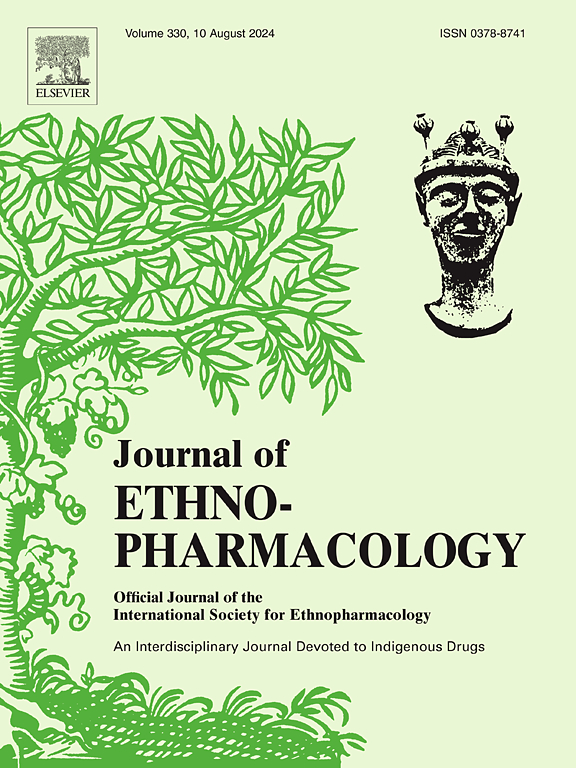Bu Zhong Yi Qi Tang targets key monocyte-associated genes to enhance sepsis therapy
IF 5.4
2区 医学
Q1 CHEMISTRY, MEDICINAL
引用次数: 0
Abstract
Ethnopharmacological relevance
Sepsis is a life-threatening condition resulting from an uncontrolled immune response to infection, leading to organ dysfunction and severe complications. Bu Zhong Yi Qi Tang (BZYQT), a traditional Chinese medicinal formulation, has been recognized for its diverse pharmacological effects, particularly in modulating immune responses and alleviating inflammation. However, the specific role and mechanism of BZYQT in the adjunctive treatment of sepsis are still unclear.
Aim of the study
To investigate the role and underlying mechanisms of BZYQT in the adjunctive therapy of sepsis.
Materials and methods
scRNA-seq was employed to analyze PBMCs from patients with sepsis and healthy controls, identifying cell populations and functional states. Pseudotime and cell-cell communication analyses were conducted to investigate the origins and interactions of Sep_monocytes. hdWGCNA and machine learning techniques were utilized to identify key genes. The adjuvant therapeutic efficacy of BZYQT was assessed in a cecal ligation and puncture (CLP) mouse model, as well as in clinical trials.
Results
Seven populations of PBMCs and twelve subclusters of monocytes were identified, with two subclusters (Sep_monocytes) enriched in sepsis patients. Furthermore, critical gene modules were identified, with METTL9, SAT1, and SRGN being pinpointed as potential sepsis biomarkers. Notably, BZYQT was found to target these genes, modulating their expression. In the CLP mouse model, BZYQT administration (0.2 ml/10 g/d) in combination with imipenem/cilastatin (50 mg/kg/d) led to improved survival rates, significantly reduced bacterial loads, diminished inflammation, and enhanced antibacterial effects. Clinically, BZYQT alleviated symptoms, modulated immune cells, and reduced inflammatory markers, underscoring its potential efficacy as an adjunctive therapy for sepsis.
Conclusion
BZYQT enhances sepsis therapy by targeting critical monocyte-associated genes, thereby modulating immune responses and reducing inflammation.

补中益气汤靶向关键单核细胞相关基因增强脓毒症治疗。
民族药理学相关性:败血症是一种危及生命的疾病,由对感染的免疫反应失控引起,导致器官功能障碍和严重并发症。补中益气汤是一种传统的中药制剂,具有多种药理作用,特别是在调节免疫反应和减轻炎症方面。然而,BZYQT在脓毒症辅助治疗中的具体作用和机制尚不清楚。目的:探讨BZYQT在脓毒症辅助治疗中的作用及其机制。材料和方法:采用scRNA-seq分析脓毒症患者和健康对照的PBMCs,确定细胞群和功能状态。假时间和细胞间通讯分析探讨了Sep_monocytes的起源和相互作用。利用hdWGCNA和机器学习技术鉴定关键基因。在盲肠结扎穿刺(CLP)小鼠模型和临床试验中评估BZYQT的辅助治疗效果。结果:共鉴定出7个pbmc群和12个单核细胞亚簇,其中2个亚簇(Sep_monocytes)在脓毒症患者中富集。此外,鉴定了关键基因模块,METTL9、SAT1和SRGN被确定为潜在的败血症生物标志物。值得注意的是,BZYQT被发现靶向这些基因,调节它们的表达。在CLP小鼠模型中,BZYQT给药(0.2 ml/10 g/d)联合亚胺培南/西司他汀(50 mg/kg/d)可提高存活率,显著降低细菌负荷,减轻炎症,增强抗菌作用。临床上,BZYQT可缓解症状,调节免疫细胞,降低炎症标志物,强调其作为脓毒症辅助治疗的潜在疗效。结论:BZYQT通过靶向关键的单核细胞相关基因,从而调节免疫反应,减轻炎症,从而增强败血症治疗。
本文章由计算机程序翻译,如有差异,请以英文原文为准。
求助全文
约1分钟内获得全文
求助全文
来源期刊

Journal of ethnopharmacology
医学-全科医学与补充医学
CiteScore
10.30
自引率
5.60%
发文量
967
审稿时长
77 days
期刊介绍:
The Journal of Ethnopharmacology is dedicated to the exchange of information and understandings about people''s use of plants, fungi, animals, microorganisms and minerals and their biological and pharmacological effects based on the principles established through international conventions. Early people confronted with illness and disease, discovered a wealth of useful therapeutic agents in the plant and animal kingdoms. The empirical knowledge of these medicinal substances and their toxic potential was passed on by oral tradition and sometimes recorded in herbals and other texts on materia medica. Many valuable drugs of today (e.g., atropine, ephedrine, tubocurarine, digoxin, reserpine) came into use through the study of indigenous remedies. Chemists continue to use plant-derived drugs (e.g., morphine, taxol, physostigmine, quinidine, emetine) as prototypes in their attempts to develop more effective and less toxic medicinals.
 求助内容:
求助内容: 应助结果提醒方式:
应助结果提醒方式:


